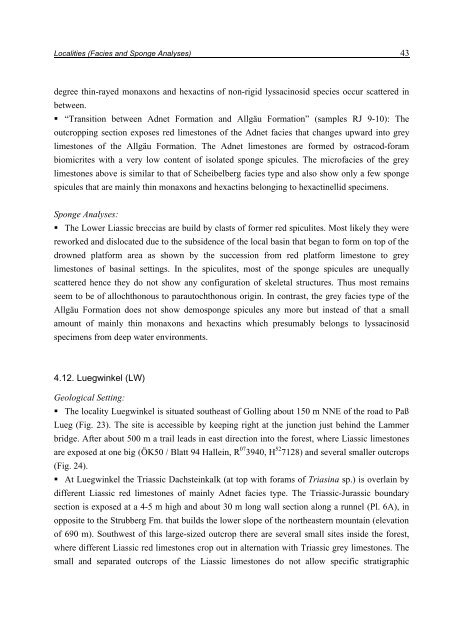Porifera-microbialites of the Lower Liassic (Northern Calcareous ...
Porifera-microbialites of the Lower Liassic (Northern Calcareous ...
Porifera-microbialites of the Lower Liassic (Northern Calcareous ...
You also want an ePaper? Increase the reach of your titles
YUMPU automatically turns print PDFs into web optimized ePapers that Google loves.
Localities (Facies and Sponge Analyses) 43<br />
degree thin-rayed monaxons and hexactins <strong>of</strong> non-rigid lyssacinosid species occur scattered in<br />
between.<br />
� “Transition between Adnet Formation and Allgäu Formation” (samples RJ 9-10): The<br />
outcropping section exposes red limestones <strong>of</strong> <strong>the</strong> Adnet facies that changes upward into grey<br />
limestones <strong>of</strong> <strong>the</strong> Allgäu Formation. The Adnet limestones are formed by ostracod-foram<br />
biomicrites with a very low content <strong>of</strong> isolated sponge spicules. The micr<strong>of</strong>acies <strong>of</strong> <strong>the</strong> grey<br />
limestones above is similar to that <strong>of</strong> Scheibelberg facies type and also show only a few sponge<br />
spicules that are mainly thin monaxons and hexactins belonging to hexactinellid specimens.<br />
Sponge Analyses:<br />
� The <strong>Lower</strong> <strong>Liassic</strong> breccias are build by clasts <strong>of</strong> former red spiculites. Most likely <strong>the</strong>y were<br />
reworked and dislocated due to <strong>the</strong> subsidence <strong>of</strong> <strong>the</strong> local basin that began to form on top <strong>of</strong> <strong>the</strong><br />
drowned platform area as shown by <strong>the</strong> succession from red platform limestone to grey<br />
limestones <strong>of</strong> basinal settings. In <strong>the</strong> spiculites, most <strong>of</strong> <strong>the</strong> sponge spicules are unequally<br />
scattered hence <strong>the</strong>y do not show any configuration <strong>of</strong> skeletal structures. Thus most remains<br />
seem to be <strong>of</strong> allochthonous to parautochthonous origin. In contrast, <strong>the</strong> grey facies type <strong>of</strong> <strong>the</strong><br />
Allgäu Formation does not show demosponge spicules any more but instead <strong>of</strong> that a small<br />
amount <strong>of</strong> mainly thin monaxons and hexactins which presumably belongs to lyssacinosid<br />
specimens from deep water environments.<br />
4.12. Luegwinkel (LW)<br />
Geological Setting:<br />
� The locality Luegwinkel is situated sou<strong>the</strong>ast <strong>of</strong> Golling about 150 m NNE <strong>of</strong> <strong>the</strong> road to Paß<br />
Lueg (Fig. 23). The site is accessible by keeping right at <strong>the</strong> junction just behind <strong>the</strong> Lammer<br />
bridge. After about 500 m a trail leads in east direction into <strong>the</strong> forest, where <strong>Liassic</strong> limestones<br />
are exposed at one big (ÖK50 / Blatt 94 Hallein, R 07 3940, H 52 7128) and several smaller outcrops<br />
(Fig. 24).<br />
� At Luegwinkel <strong>the</strong> Triassic Dachsteinkalk (at top with forams <strong>of</strong> Triasina sp.) is overlain by<br />
different <strong>Liassic</strong> red limestones <strong>of</strong> mainly Adnet facies type. The Triassic-Jurassic boundary<br />
section is exposed at a 4-5 m high and about 30 m long wall section along a runnel (Pl. 6A), in<br />
opposite to <strong>the</strong> Strubberg Fm. that builds <strong>the</strong> lower slope <strong>of</strong> <strong>the</strong> nor<strong>the</strong>astern mountain (elevation<br />
<strong>of</strong> 690 m). Southwest <strong>of</strong> this large-sized outcrop <strong>the</strong>re are several small sites inside <strong>the</strong> forest,<br />
where different <strong>Liassic</strong> red limestones crop out in alternation with Triassic grey limestones. The<br />
small and separated outcrops <strong>of</strong> <strong>the</strong> <strong>Liassic</strong> limestones do not allow specific stratigraphic

















